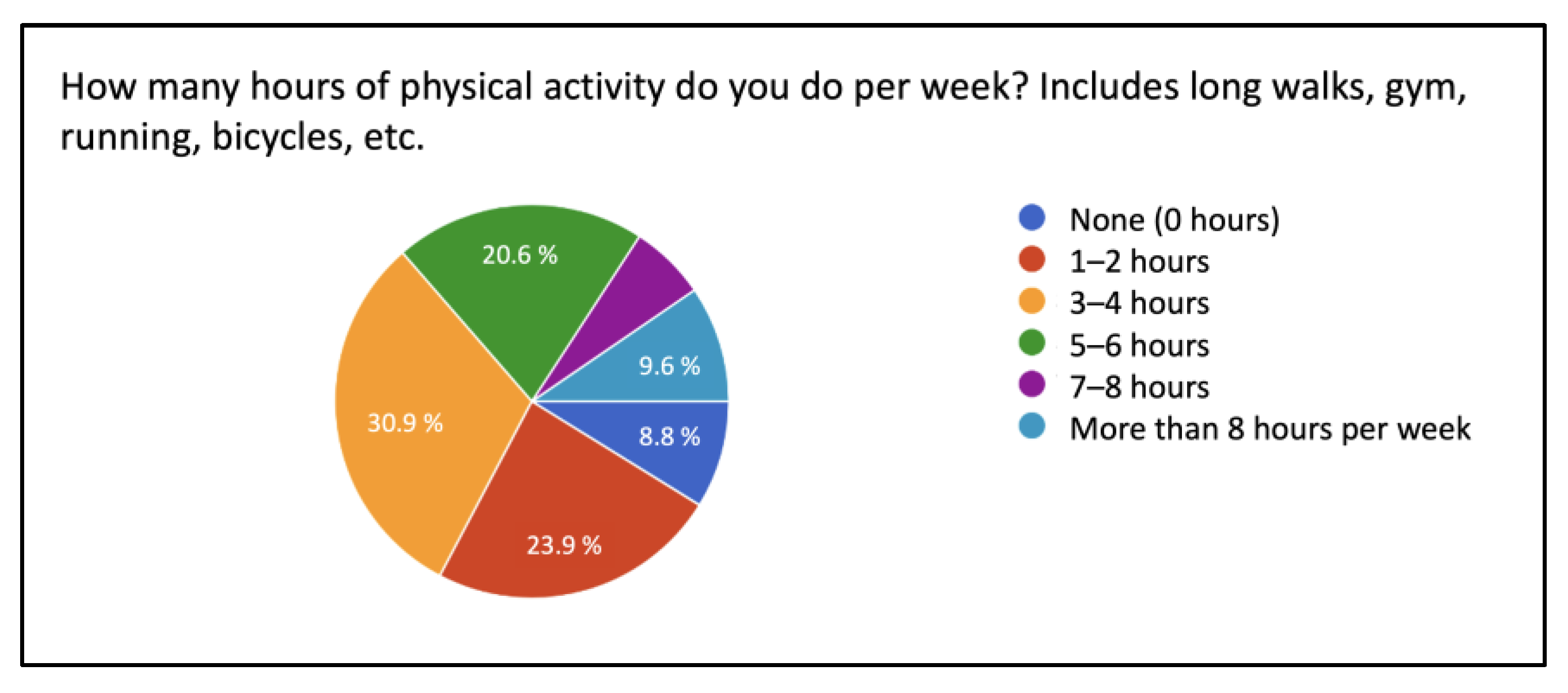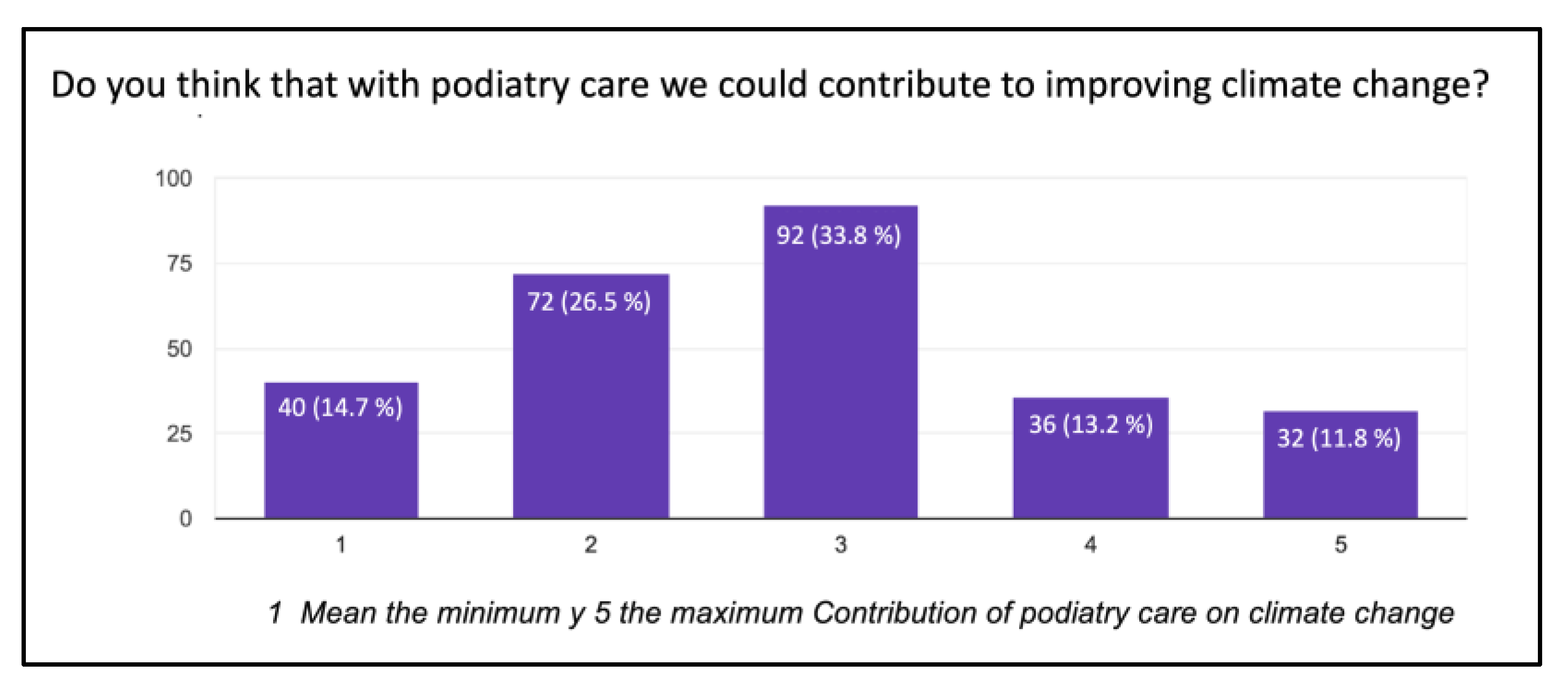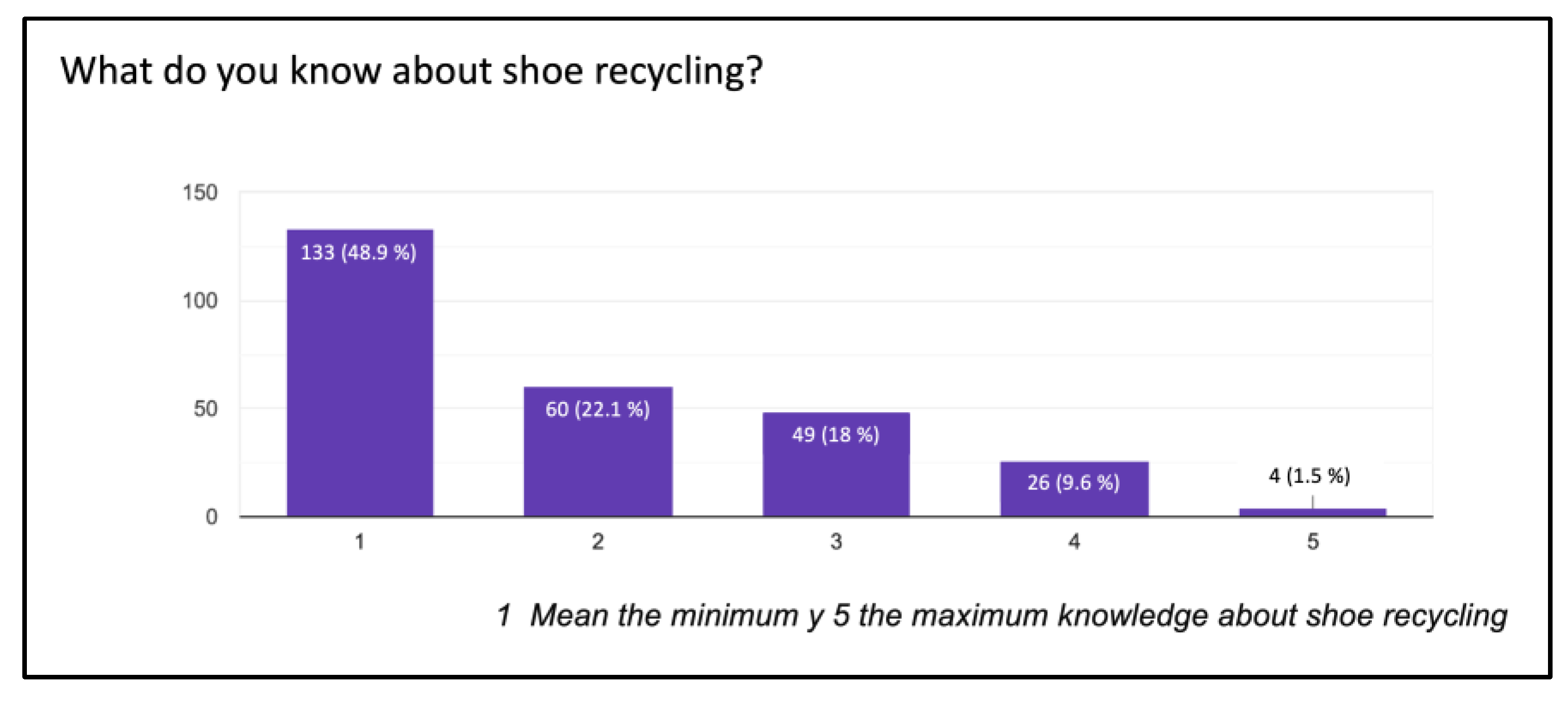Degree of Knowledge and Commitment of the Spanish Podiatry Community to Green Podiatry: A Preliminary Report
Abstract
:1. Introduction
2. Materials and Methods
Participants
- 1-to-5-point Likert-scale questions:
- Do you know the concept of “Green Podiatry”?
- Do you worry about climate change?
- Do you know what the carbon footprint is?
- Do you think podiatrists have a major role in climate change?
- Do you think that podiatric attention could help contribute to improving climate change?
- Is there evidence that single-use items are always safer than reusable ones?
- Do you consider exercise as a first-line treatment?
- Have you prescribed any treatment without being necessary?
- Do you know about green shoes, made from natural fibers (raffia palm or banana skin)?
- Do you know about the recycling of shoes?
- Do you know the United Nations’ sustainable development goals?
- Do you think podiatrists are in a great position to act and educate people on climate change?
- Short text questions:
- 13.
- If you know them, do you know in which of them the “green podiatry” could collaborate?
- 14.
- How do you think we could act and educate on climate change?
- Basic demographic information:
- -
- Your age now?
- -
- How many years as a podiatrist? OR are you a podiatry student?
- -
- Do you own a car? Yes/No
- -
- If yes, is your car: electric/hybrid/fuel
- -
- Do you ride a bicycle? Yes/No
- -
- Do you use public transport (bus, train)? Yes/No
- -
- How many hours physical activity each week? (include walking, riding, gym, sports)
- -
- What is your BMI?
- -
- Are you vegetarian or vegan? Yes/No
- Outcome Measures:
- -
- Gender distribution among participants.
- -
- Age range of participants.
- -
- Level of knowledge about green podiatry and sustainable footwear.
- -
- Commuting habits in relation to climate change.
- -
- Weekly physical activity level.
- -
- Frequency of prescribing unnecessary treatments to patients.
- -
- Use of physical activity as a first-line treatment option.
- -
- The responses will be tabulated to determine if specific practices are already being adopted by Spanish podiatrists.
3. Results
3.1. Transport and Physical Activity
3.2. Degree of Knowledge in Podiatry and Sustainable Development Goals (SDGs)
3.3. Actions of Commitment to Climate Change
- -
- Reducing single-use materials.
- -
- Educating ourselves about footwear recycling and sustainable footwear.
- -
- Promoting and prescribing physical exercise as a therapeutic measure.
4. Discussion
- -
- Reducing single-use materials, as a significant amount of plastic waste is generated.
- -
- Not immediately prescribing foot orthotics without first trying specific exercises for the pathology.
- -
- Organizing workshops or lectures for podiatrists on footwear recycling and “green footwear” to raise awareness and be able to recommend them to patients.
5. Conclusions
- -
- The podiatrists who responded to the survey do not engage in sustainable commuting practices.
- -
- Spanish podiatrists are unaware of the concept of “green podiatry”, although they express significant concern about climate change. However, they seem to have some knowledge about carbon footprints. Almost half of them are unsure if podiatry plays an important role in climate change.
- -
- The actions of the surveyed podiatrists, such as prioritizing exercise as a primary treatment and avoiding unnecessary treatments, are favorable for addressing climate change. However, the majority of them have no knowledge about footwear recycling and “green shoes”. Spanish podiatrists prioritize reducing single-use materials and express interest in learning about footwear recycling and sustainable shoes.
- Embrace the three pillars of green podiatry: exercise, evidence, and daily practice.
- Utilize walking as a carbon-neutral means of transportation and promote physical activity as a means to improve health.
Author Contributions
Funding
Institutional Review Board Statement
Informed Consent Statement
Conflicts of Interest
References
- Evans, A.M. ‘Green podiatry’—Reducing our carbon footprints. Lessons from a sustainability panel. J. Foot Ankle. Res. 2021, 14, 59. [Google Scholar] [CrossRef] [PubMed]
- Evans, A.M. Sustainable healthcare—Time for ‘Green Podiatry’. J. Foot Ankle. Res. 2021, 14, 45. [Google Scholar] [CrossRef] [PubMed]
- Evans, A.M. Incorporating ‘Green Podiatry’ into your clinic, and into your life. J. Foot Ankle. Res. 2022, 15, 87. [Google Scholar] [CrossRef] [PubMed]
- Gorji, S.; Gorji, A. COVID-19 pandemic: The possible influence of the long-term ignorance about climate change. Environ. Sci. Pollut. Res. 2021, 28, 15575–15579. [Google Scholar] [CrossRef]
- del Carmen Lacy-Niebla, M. El cambio climático y la pandemia de COVID-19. Arch. Cardiol. Mex. 2021, 91, 269–271. [Google Scholar]
- Chodzko-Zajko, W.; Schwingel, A.; Romo-Pérez, V. Un análisis crítico sobre las recomendaciones de actividad física en España. Gac. Sanit. 2012, 26, 525–533. [Google Scholar] [CrossRef] [PubMed]
- Caballero, R.; Franco, P.; Mustaca, A.; Jakovcevic, A. Uso de la Bicicleta como Medio de Transporte: Influencia de los Factores Psicológicos. Una Revisión de la Literatura. Psico 2014, 45, 316–324. [Google Scholar] [CrossRef]
- Gómez, C. Objetivos de Desarrollo Sostenible (ODS): Una revisión crítica. Papeles Relac. Ecosociales Cambio Glob. 2017, 140, 107–118. [Google Scholar]
- Jingi, A.M.; Noubiap, J.J.N. Cardiovascular risk factors awareness and prevalence among primary care physicians: An insight from the West region Awareness Initiative Survey to fight cardiovascular disease (WAIT-CVD) in Cameroon. BMC Res. Notes 2015, 8, 762. [Google Scholar] [CrossRef] [PubMed]
- Borgan, S.; Jassim, G.; Marhoon, Z.; Ibrahim, M. The lifestyle habits and wellbeing of physicians in Bahrain: A cross-sectional study. BMC Public Health 2015, 15, 655. [Google Scholar] [CrossRef] [PubMed]
- Boffino, L.; Meléndez, I.; Rodríguez, A. Pie Plano Pediátrico. Obtenido de Pie Plano Pediátrico. 2022. Available online: https://medi.usal.edu.ar/archivos/medi/otros/pie_plano_pediatrico.pdf (accessed on 28 July 2023).
- Alyafei, M.; Alchawa, M.; Farooq, A.; Selim, N.; Bougmiza, I. Physical Activity among Primary Health Care Physicians and Its Impact on Counseling Practices. Biomed. Hub. 2023, 8, 31–41. [Google Scholar] [CrossRef] [PubMed]
- Abu Saad, H.; Low, P.; Jamaluddin, R.; Chee, H. Level of Physical Activity and Its Associated Factors among Primary Healthcare Workers in Perak, Malaysia. Int. J. Environ. Res. Public Health 2020, 17, 5947. [Google Scholar] [CrossRef] [PubMed]
- Walsh, J. Exercise counseling by primary care physicians in the era of managed care. Am. J. Prev. Med. 1999, 16, 307–313. [Google Scholar] [CrossRef] [PubMed]
- Hidalgo, K.D.; Mielke, G.I.; Parra, D.C.; Lobelo, F.; Simões, E.J.; Gomes, G.O.; Florindo, A.A.; Bracco, M.; Moura, L.; Brownson, R.C.; et al. Health promoting practices and personal lifestyle behaviors of Brazilian health professionals. BMC Public Health 2016, 16, 1114. [Google Scholar] [CrossRef] [PubMed]
- Warburton, D.; Whitney, N.C.; Shannon, S.D.B. Health benefits of physical activity: The evidence. Can. Med. Assoc. J. 2006, 174, 801–809. [Google Scholar] [CrossRef] [PubMed]
- Pérez, T.I.; Mlvlg, V. Hospitales Sustentables. Mexico. 2014. Available online: https://docplayer.es/11383189-Hospitales-sustentables-2.html (accessed on 28 July 2023).
- Carbonel Blasco, M.; Pérez Limiñana, M.A.; Ruzafa Silvestre, C.; Orgilés Calpena, E.; Arán Aís, F. Sustainable Reactive Polyurethane Hot Melt Adhesives Based on Vegetable Polyols for Footwear Industry. Polymers 2022, 14, 284. [Google Scholar] [CrossRef] [PubMed]
- Morales-Cerrada, R.; Tavernier, R.; Caillol, S. Fully Bio-Based Thermosetting Polyurethanes from Bio-Based Polyols and Isocyanates. Polymers 2021, 13, 1255. [Google Scholar] [CrossRef] [PubMed]
- Mokhtari, C.; Malek, F.; Halila, S.; Naceur Belgacem, M.; Khiari, R. New Biobased Polyurethane Materials from Modified Vegetable Oil. J. Renew. Mater. 2021, 9, 1213–1223. [Google Scholar] [CrossRef]
- Banday, A.; Want, F.; Alris, F.; Alrayes, M.; Alenzi, M. A Cross-sectional Study on the Prevalence of Physical Activity Among Primary Health Care Physicians in Aljouf Region of Saudi Arabia. Mater. Socio Medica 2015, 27, 263. [Google Scholar] [CrossRef] [PubMed]




Disclaimer/Publisher’s Note: The statements, opinions and data contained in all publications are solely those of the individual author(s) and contributor(s) and not of MDPI and/or the editor(s). MDPI and/or the editor(s) disclaim responsibility for any injury to people or property resulting from any ideas, methods, instructions or products referred to in the content. |
© 2023 by the authors. Licensee MDPI, Basel, Switzerland. This article is an open access article distributed under the terms and conditions of the Creative Commons Attribution (CC BY) license (https://creativecommons.org/licenses/by/4.0/).
Share and Cite
Gómez-Ruiz, L.; Martínez-Nova, A.; Simón-Pérez, E.; Morán-Cortés, J.F. Degree of Knowledge and Commitment of the Spanish Podiatry Community to Green Podiatry: A Preliminary Report. Int. J. Environ. Res. Public Health 2023, 20, 6761. https://doi.org/10.3390/ijerph20186761
Gómez-Ruiz L, Martínez-Nova A, Simón-Pérez E, Morán-Cortés JF. Degree of Knowledge and Commitment of the Spanish Podiatry Community to Green Podiatry: A Preliminary Report. International Journal of Environmental Research and Public Health. 2023; 20(18):6761. https://doi.org/10.3390/ijerph20186761
Chicago/Turabian StyleGómez-Ruiz, Lara, Alfonso Martínez-Nova, Eduardo Simón-Pérez, and Juan Francisco Morán-Cortés. 2023. "Degree of Knowledge and Commitment of the Spanish Podiatry Community to Green Podiatry: A Preliminary Report" International Journal of Environmental Research and Public Health 20, no. 18: 6761. https://doi.org/10.3390/ijerph20186761
APA StyleGómez-Ruiz, L., Martínez-Nova, A., Simón-Pérez, E., & Morán-Cortés, J. F. (2023). Degree of Knowledge and Commitment of the Spanish Podiatry Community to Green Podiatry: A Preliminary Report. International Journal of Environmental Research and Public Health, 20(18), 6761. https://doi.org/10.3390/ijerph20186761






